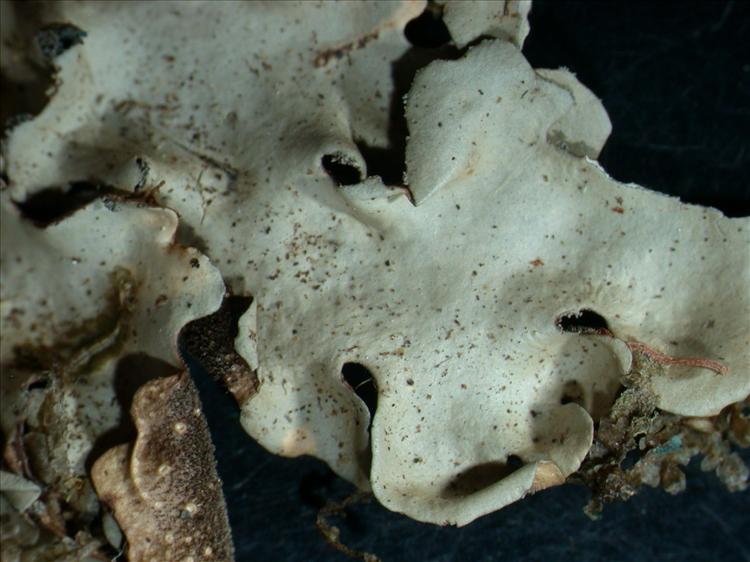
Consortium of Lichen Herbaria
- building a Global Consortium of Bryophytes and Lichens as keystones of cryptobiotic communities -
- Home
- Search
- Images
- Species Checklists
- US States: O-Z >
- US National Parks
- Central America
- South America
- US National Parks
- Southern Subpolar Region
|
|
|
|
Family: Peltigeraceae
|
Nash, T.H., Ryan, B.D., Gries, C., Bungartz, F., (eds.) 2004. Lichen Flora of the Greater Sonoran Desert Region. Vol 2. Thallus: foliose, irregularly spreading, 1.5-3(-5) cm in diam., pliable, flabby when moist, very papery and fragile when dry, loosely attached centrally, with free and ascending margins lobes: irregularly laciniate, noticeably con-cave-subcanaliculate centrally, shallowly to deeply incised and appearing ragged, 4-10(-15) mm wide, 10-30 mm long, complex-imbricate centrally; apices: discrete to subimbricate; margins: entire, sinuous, ascending, shallowly scalloped to occasionally lobulate, incised, not noticeably thickened below upper surface: dark glaucous blue-gray, olivaceous glaucous to blue-black, suffused brown or red when moist, pale olivaceous gray or predominantly yellow-brown, suffused red-brown at apices when dry, smooth, undulate, shallowly wrinkled or punctate-impressed in parts, dull, with white, netted maculae conspicuous at margins and centrally [best seen when moist (x10 lens)], without isidia or soredia, phyllidiate phyllidia: subterete to flattened, distinctly coralloid-branched, often in congested palmate clusters, along margins and occasionally submarginally along small cracks or tears in the upper cortex medulla: white, K- photobiont: cyanobacterial lower surface: pale cream-colored or yellowish buff marginally, darkening to red-brown centrally, smooth to wrinkled-papillate, glabrous in a broad marginal zone or tomentose from margins to center; tomentum: short, arachnoid (x10 lens) at margins, thicker and rather woolly centrally with here and there stout fascicles of dark brown-black rhizines 4-6 mm long cyphellae: often white pruinose or granular-crystalline (x10 lens), prominent, numerous, thelotremoid at margins, widely scattered and sunken in tomentum centrally, 0.1-1(-2) mm in diam., deeply urceolate, gaping away from margins and sometimes eroding down to medulla or through to upper surface, with narrow, truncate-conical, distinctly raised margins concolorous with lower cortex, with a white to pale buff basal membrane Apothecia: not seen Pycnidia: rare, scattered here and there near margins, immersed, visible as pale fawn-colored swellings up to 0.5 mm in diam., with minute, punctiform, pale red-brown ostiole conidia: bacilliform, straight, 3-5 x 1 µm Spot tests: all negative Secondary metabolites: none detected. Substrate and ecology: on soil and among mosses on rocks (basalt, rhyolite) in mixed conifer forest, 1950-2990 m World distribution: Brazil, Costa Rica, and Arizona Sonoran distribution: mountains of southeastern Arizona. Notes: Details of apothecial anatomy for this species are given by Hue (1901: 96-97) as "epihymenium slightly brown; hymenium to 140 µm tall; hypothecium yellowish; ascospores hyaline, 1-3-septate, (24-)26-32(-36) x 7-10 µm". The specimens seen from Arizona and Mexico were not fertile, but their thallus morphology seems most consistent with the published descriptions (see Hue 1901: 96) and with authentic material annotated by Müller Argoviensis (G 002984). |
Powered by Symbiota
























